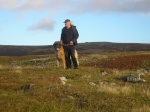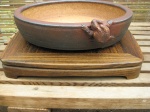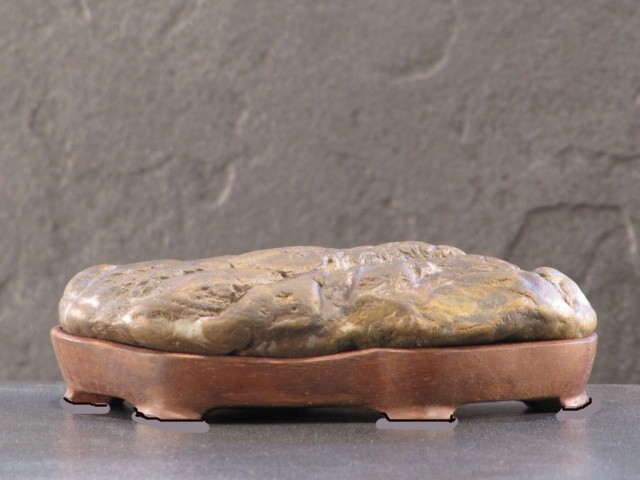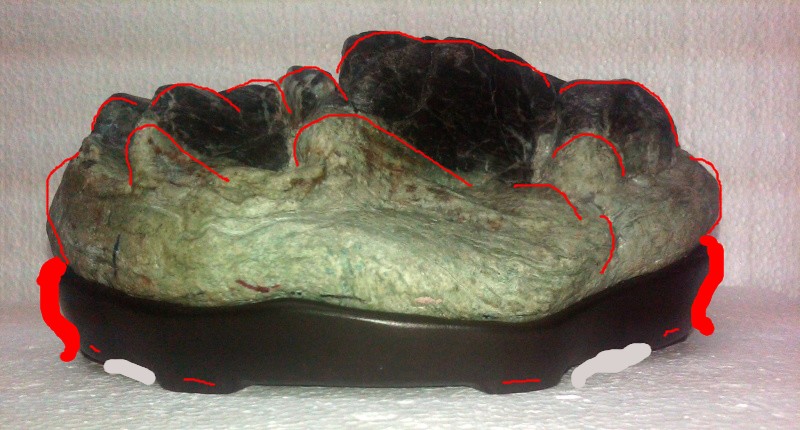Greek stone
5 posters
Page 1 of 1
 Greek stone
Greek stone
Hello.
A stone from Crete,
11,5 cm.
Sunip
 [/url[url=https://servimg.com/view/16274585/225]
[/url[url=https://servimg.com/view/16274585/225] [/url[url=https://servimg.com/view/16274585/226]
[/url[url=https://servimg.com/view/16274585/226]
A stone from Crete,
11,5 cm.
Sunip
 [/url[url=https://servimg.com/view/16274585/225]
[/url[url=https://servimg.com/view/16274585/225] [/url[url=https://servimg.com/view/16274585/226]
[/url[url=https://servimg.com/view/16274585/226]
sunip- Member
 Re: Greek stone
Re: Greek stone
Hello Yvonne,
This stone is 11,5 cm. long
6,5 cm deep
2,5 cm, high.
I am not sure about the daiza shape for this one.
Sunip
This stone is 11,5 cm. long
6,5 cm deep
2,5 cm, high.
I am not sure about the daiza shape for this one.
Sunip
sunip- Member
 Re: Greek stone
Re: Greek stone
Hi Sunip
I like the stone laying dawn.....
Sink the stone into the wood, and show the picture here....I am sure you will have a responce.
Kind regards Yvonne
I like the stone laying dawn.....
Sink the stone into the wood, and show the picture here....I am sure you will have a responce.
Kind regards Yvonne
Guest- Guest
 Re: Greek stone
Re: Greek stone
I love the stone Sunip.
Crete is a very diverse landscape, did this come from the high mountain area?
Regards Chris
Crete is a very diverse landscape, did this come from the high mountain area?
Regards Chris

chris- Member
 Re: Greek stone
Re: Greek stone
Hello Chris,
The Ida mountains are beautiful indeed but this stone is from the south cost area.
I am eagerly waiting how your hawthorn will leave out, the one i got from you at the Noelanders.
Sunip,
The Ida mountains are beautiful indeed but this stone is from the south cost area.
I am eagerly waiting how your hawthorn will leave out, the one i got from you at the Noelanders.
Sunip,
sunip- Member
 Re: Greek stone
Re: Greek stone
As I look at your stone, I too like the horizontal look to it.
One part of me ( the unconventional part) as i look at the first picture, wants to see a daiza built that just support the flat center part and allow the ends to turn up into space.
Th more conventional me says, no cover the entire bottom with the daiza and adjust up with wood to rise with the corners.
I picture that stone in my mind's eye as something along a sea shore. I could see it in a suiban filled with water
and maybe a small Seal figurine on one end.
One part of me ( the unconventional part) as i look at the first picture, wants to see a daiza built that just support the flat center part and allow the ends to turn up into space.
Th more conventional me says, no cover the entire bottom with the daiza and adjust up with wood to rise with the corners.
I picture that stone in my mind's eye as something along a sea shore. I could see it in a suiban filled with water
and maybe a small Seal figurine on one end.

dick benbow- Member
 Re: Greek stone
Re: Greek stone
Hi Sunip, I can feel a stone collecting trip coming on!
The Hawthorns hear are starting to shine at the buds
Regards Chris
The Hawthorns hear are starting to shine at the buds
Regards Chris

chris- Member
 Re: Greek stone
Re: Greek stone
[quote="chris"]Hi Sunip, I can feel a stone collecting trip coming on!
The Hawthorns hear are starting to shine at the buds
Hello Chris,
I got that feeling to,
both, buds and collecting trip.
Regards, Sunip
The Hawthorns hear are starting to shine at the buds
Hello Chris,
I got that feeling to,
both, buds and collecting trip.
Regards, Sunip
sunip- Member
 Re: Greek stone
Re: Greek stone
Hello Dick,dick benbow wrote:As I look at your stone, I too like the horizontal look to it.
One part of me ( the unconventional part) as i look at the first picture, wants to see a daiza built that just support the flat center part and allow the ends to turn up into space.
Th more conventional me says, no cover the entire bottom with the daiza and adjust up with wood to rise with the corners.
I picture that stone in my mind's eye as something along a sea shore. I could see it in a suiban filled with water
and maybe a small Seal figurine on one end.
I see the stone lying horizontal like a shore stone,
i made a picture from above to show the deep natural gorges.
I was thinking of a daiza with the sides filled up and at the same time it looks good on a rectangle black jitta
like Chris Cochrane mentioned where he was writing of a (new) Japanese Zen approach published in the
California Aiseki Kai issue, oct 2009.
(mar 12, My foreign stones - Yvonne Graubaek)
Sunip
sunip- Member
 Re: Greek stone
Re: Greek stone
Hello.
This stone is from the same site as the previous one.
Sunip
 [/url[url=https://servimg.com/view/16274585/241]
[/url[url=https://servimg.com/view/16274585/241]
This stone is from the same site as the previous one.
Sunip
 [/url[url=https://servimg.com/view/16274585/241]
[/url[url=https://servimg.com/view/16274585/241]
sunip- Member
 Re: Greek stone
Re: Greek stone
Hello,
Here the stone on a seat, i am not completely satisfied yet, maybe i change some things.
Specially the backside on the third picture, is a bit heavy this way.
Sunip
 [/url[url=https://servimg.com/view/16274585/276]
[/url[url=https://servimg.com/view/16274585/276] [/url[url=https://servimg.com/view/16274585/277]
[/url[url=https://servimg.com/view/16274585/277]
Here the stone on a seat, i am not completely satisfied yet, maybe i change some things.
Specially the backside on the third picture, is a bit heavy this way.
Sunip
 [/url[url=https://servimg.com/view/16274585/276]
[/url[url=https://servimg.com/view/16274585/276] [/url[url=https://servimg.com/view/16274585/277]
[/url[url=https://servimg.com/view/16274585/277]
sunip- Member
 Re: Greek stone
Re: Greek stone
Hello Peter.
Thank you for your vision.
A lower and more subtile foot underlines the horizontal character of the stone and gives more space to the horizontal lines.
Sunip
Thank you for your vision.
A lower and more subtile foot underlines the horizontal character of the stone and gives more space to the horizontal lines.
Sunip
sunip- Member
 my humble opinion
my humble opinion
Hey Sunip maybe you could consider lazy legs, next time?
I think when feet are tucked, undercut and not so provokingly visible,
a more stable feeling and grounding effect occurs.
Massiveness of landscape view is unobstructed and so better appreciated,
even if the daiza is thicker which signals natural uncut bottom, best possible.
offered as expert on nothing...

there are feet at both ends, just hard to see at this angle...
I think when feet are tucked, undercut and not so provokingly visible,
a more stable feeling and grounding effect occurs.
Massiveness of landscape view is unobstructed and so better appreciated,
even if the daiza is thicker which signals natural uncut bottom, best possible.
offered as expert on nothing...

there are feet at both ends, just hard to see at this angle...

stonener- Member
 Re: Greek stone
Re: Greek stone
[quote="stonener"]Hey Sunip maybe you could consider lazy legs, next time?
I think when feet are tucked, undercut and not so provokingly visible,
a more stable feeling and grounding effect occurs.
Massiveness of landscape view is unobstructed and so better appreciated,
even if the daiza is thicker which signals natural uncut bottom, best possible.
Hello Stonener.
Thanks, i red your thoughts on lazy feet in the other post and thought -it depends, it might work with certain stones-
( i remember the answer of Yvonne as well -just lazy feet-),
let me try to share some others thoughts on this now to get possibly some further nuance.
A daiza isolates and connects the stone from and to the environment in a certain designed way, so we can appreciate the stone.
I used this specific shape for the feet here, because for me they give the horizontal lines in the stone more space to flow.
Your preferred shape would stop that movement to much i feel (in another way provokingly visible),
they produce together with a straight wall of the seat, vertical lines that would cut into the stone.
The mass of the wood, the thickness, is important here for connection to the ground and does the trick together with a subtile outward flowing of the feet and a light convex wall of the seat (not concave),
the placement of the feet is important as well.
Naturally because of personal appreciation, different aspects in a stone will get emphasize on times i gather.
The idea of Peter to lower the feet a bit, confirms my feeling that the whole is floating to much
and make therefore the feet provokingly visible.
See where it goes.
Sunip
I think when feet are tucked, undercut and not so provokingly visible,
a more stable feeling and grounding effect occurs.
Massiveness of landscape view is unobstructed and so better appreciated,
even if the daiza is thicker which signals natural uncut bottom, best possible.
Hello Stonener.
Thanks, i red your thoughts on lazy feet in the other post and thought -it depends, it might work with certain stones-
( i remember the answer of Yvonne as well -just lazy feet-),
let me try to share some others thoughts on this now to get possibly some further nuance.
A daiza isolates and connects the stone from and to the environment in a certain designed way, so we can appreciate the stone.
I used this specific shape for the feet here, because for me they give the horizontal lines in the stone more space to flow.
Your preferred shape would stop that movement to much i feel (in another way provokingly visible),
they produce together with a straight wall of the seat, vertical lines that would cut into the stone.
The mass of the wood, the thickness, is important here for connection to the ground and does the trick together with a subtile outward flowing of the feet and a light convex wall of the seat (not concave),
the placement of the feet is important as well.
Naturally because of personal appreciation, different aspects in a stone will get emphasize on times i gather.
The idea of Peter to lower the feet a bit, confirms my feeling that the whole is floating to much
and make therefore the feet provokingly visible.
See where it goes.
Sunip
sunip- Member
 Similar topics
Similar topics» Yuhua Stone (Rain Flower Stone)
» TUNNEL STONE
» Potomac Viewing Stone Group-- Chinese stone preferences
» Some picture stone and black stone for your appreciation
» MOUNTAIN LANDSCAPE ( Cut stone and Uncut stone )
» TUNNEL STONE
» Potomac Viewing Stone Group-- Chinese stone preferences
» Some picture stone and black stone for your appreciation
» MOUNTAIN LANDSCAPE ( Cut stone and Uncut stone )
Page 1 of 1
Permissions in this forum:
You cannot reply to topics in this forum









